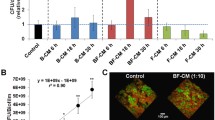Abstract
This study evaluated the effects of a polymeric biosurfactant produced by Trichosporon montevideense CLOA72 in the adhesion of Candida albicans and Candida krusei cells to human buccal epithelial cells and its interference in biofilm formation by these strains. The biofilm inhibition by biosurfactant (25 mg/mL) in C. krusei and C. albicans in polystyrene was reduced up to 79.5 and 85 %, respectively. In addition, the zeta potential and hydrodynamic diameter of the yeasts altered as a function of the biosurfactant concentration added to the cell suspension. The changes in the cell surface characteristics and the interface modification can contribute to the inhibition of the initial adherence of yeasts cells to the surface. In addition, the analyses of the biofilm matrix and planktonic cell surfaces demonstrated differences in carbohydrate and protein concentrations for the two studied strains, which may contribute to the modulation of cell adhesion or consolidation of biofilms, especially in C. krusei. This study suggests a possible application of the of CLOA72 biosurfactant in inhibiting the adhesion and formation of biofilms on biological surfaces by yeasts of the Candida genus.





Similar content being viewed by others
References
Rodrigues L, Banat IM, Teixeira J, Oliveira R. Biosurfactants: potential applications in medicine. J Antimicrob Chemother. 2006;57:609–18.
Banat IM, et al. Microbial biosurfactants production, applications and future potential. Appl Microbiol Biotechnol. 2010;4:427–44.
Kitamoto D, et al. Surface active properties and antimicrobial activities of mannosylerythritol lipids as biosurfactants produced by Candida antarctica. J Biotechnol. 1993;29:91–6.
Douglas LJ. Candida biofilms and their role in infection. Trends Microbiol. 2003;11(1):30–6.
Monteiro AS, et al. Inhibition of Candida albicans CC biofilms formation in polystyrene plate surfaces by biosurfactant produced by Trichosporon montevideense CLOA72. Colloids Surf B Biointerfaces. 2011;84:467–76.
Clinical and Laboratory Standards Institute. Performance standards for antimicrobial susceptibility testing. 23rd Informational Supplement Document M100-S23, CLSI, Wayne, 2013.
Li X, Yan Z, Xu J. Quantitative variation of biofilms among strains in natural populations of Candida albicans. Microbiology. 2003;149:353–62.
Nuryastuti T, et al. Effect of cinnamon oil on icaA expression and biofilm formation by Staphylococcus epidermidis. Appl Environ Microbiol. 2009;75:6850–5.
Millsap KW, et al. Adhesive interactions between voice prosthetic yeast and bacteria on silicone rubber in the absence and presence of saliva. Antonie Van Leeuwenhoek. 2001;79:337–43.
Kimura LH, Pearsall NN. Relationship between germination of Candida albicans and increased adherence to human buccal epithelial cells. Infect Immun. 1980;28:464–8.
Xu R. Methods to resolve mobility from electrophoretic laser light scattering measurement. Langmuir. 1993;9:2955–62.
Dubois MKA, et al. Colorimetric method for determination of sugars and related substances. Annal Chem. 1956;28:350–6.
Bradford MA. A rapid and sensitive method for the quantitation of microgram quantities of protein utilizing the principle of protein-dye binding. Anal Biochem. 1976;72:248–54.
Gould LA, et al. Mitigation of surfactants erythrocyte toxicity by egg phosphatidylcholine. J Pharm Pharmacol. 2000;52:1203–9.
Patel S, et al. In-vitro cytotoxicity activity of Solanum nigrum extract against hela cell line and vero cell line. Int J Pharm Pharm Sci. 2009;1:38–46.
Zhangi W, et al. Use of potassium hydroxide, giemsa and calcofluor white staining techniques in the microscopic evaluation of corneal scrapings for diagnosis of fungal keratitis. J Int Med Res. 2010;38:1961–7.
van Oss CJ. Interfacial forces in aqueous media. 1st ed. New York: Marcel Dekker; 1994.
Savard T, Beaulieu C, Boucher I, Champagne CP. Antimicrobial action of hydrolysed chitosan against spoilage yeasts and lactic acid bacteria of fermented vegetables. J Food Prot. 2002;65:828–33.
Monteiro AS, et al. Characterization of new biosurfactant produced by Trichosporon montevideense CLOA 72 isolated from dairy industry effluents. J Basic Microbiol. 2009;49:553–63.
Neu TR. Significance of bacterial surface-active compounds in interaction of bacteria with interfaces. Microbiol Rev. 1996;60:151–66.
Santana IL, et al. Dietary carbohydrates modulate Candida albicans biofilm development on the denture surface. PLoS One. 2013;8(e64645):2013.
Samaranayake YH, et al. Relationship between the cell surface hydrophobicity and adherence of Candida krusei and Candida albicans to epithelial and denture acrylic surfaces. APMIS. 1995;103:707–13.
Hawser SP, et al. Biofilm formation by Candida species on the surface of catheter materials in vitro. Infect Immun. 1994;62:915–21.
Yu L, et al. Adherence of Pseudomonas aeruginosa and Candida albicans to glycosphingolipid (asialo-GM1) receptors is achieved by a conserved receptor-binding domain present on their adhesins. Infect Immun. 1994;62(5213–5219):1994.
Foldvari M, et al. Efficacy of the antiadhesin octyl O-(2-acetamido-2-deoxy-β-d-galactopyranosyl)-(1-4)-2-O-propyl-β-galactopyranoside (fimbrigal-P) in a rat oral candidiasis model. Antimicrob Agents Chemother. 2008;49:2887–94.
Acknowledgments
The authors are thankful for the financial support from Conselho Nacional de Desenvolvimento Científico e Tecnológico (CNPq: DT-310145/2011-2, MCT/CNPq-NANO: 550321/2012-8), Fundação de Amparo à Pesquisa do Estado de Minas Gerais (FAPEMIG: APQ-4432-5.02/07, APQ-01243-10, APQ-00645-12), Financiadora de Estudos e Projetos (FINEP: 0633/13) and the PROPESQ-UFJF.
Author information
Authors and Affiliations
Corresponding author
Ethics declarations
Conflict of interest
The authors declare that they have no conflict of interests.
Rights and permissions
About this article
Cite this article
Ferreira, G.F., dos Santos Pinto, B.L., Souza, E.B. et al. Biophysical Effects of a Polymeric Biosurfactant in Candida krusei and Candida albicans Cells. Mycopathologia 181, 799–806 (2016). https://doi.org/10.1007/s11046-016-0054-z
Received:
Accepted:
Published:
Issue Date:
DOI: https://doi.org/10.1007/s11046-016-0054-z




